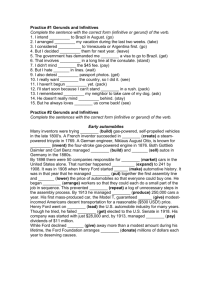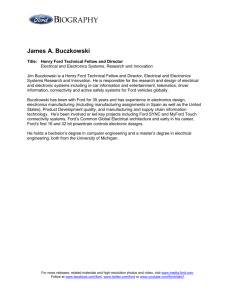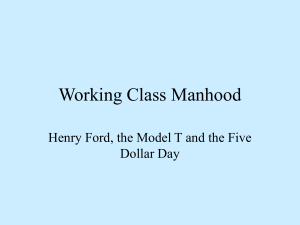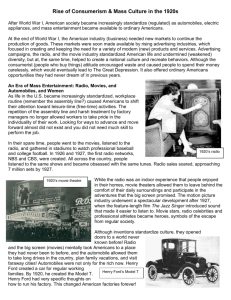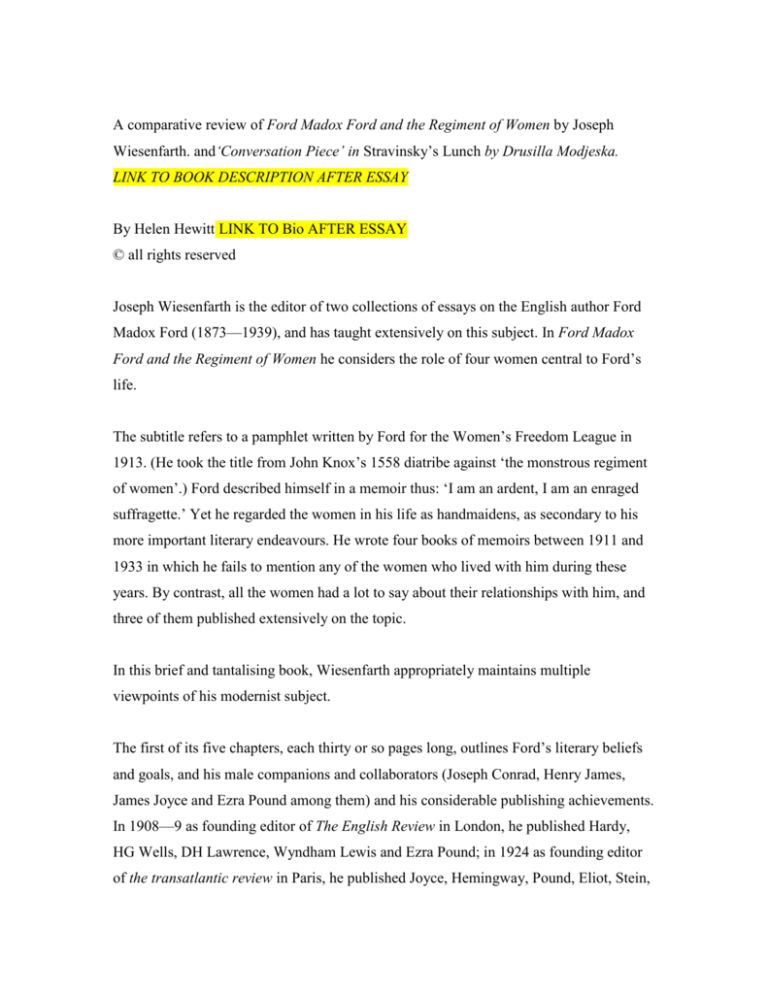
A comparative review of Ford Madox Ford and the Regiment of Women by Joseph
Wiesenfarth. and‘Conversation Piece’ in Stravinsky’s Lunch by Drusilla Modjeska.
LINK TO BOOK DESCRIPTION AFTER ESSAY
By Helen Hewitt LINK TO Bio AFTER ESSAY
© all rights reserved
Joseph Wiesenfarth is the editor of two collections of essays on the English author Ford
Madox Ford (1873—1939), and has taught extensively on this subject. In Ford Madox
Ford and the Regiment of Women he considers the role of four women central to Ford’s
life.
The subtitle refers to a pamphlet written by Ford for the Women’s Freedom League in
1913. (He took the title from John Knox’s 1558 diatribe against ‘the monstrous regiment
of women’.) Ford described himself in a memoir thus: ‘I am an ardent, I am an enraged
suffragette.’ Yet he regarded the women in his life as handmaidens, as secondary to his
more important literary endeavours. He wrote four books of memoirs between 1911 and
1933 in which he fails to mention any of the women who lived with him during these
years. By contrast, all the women had a lot to say about their relationships with him, and
three of them published extensively on the topic.
In this brief and tantalising book, Wiesenfarth appropriately maintains multiple
viewpoints of his modernist subject.
The first of its five chapters, each thirty or so pages long, outlines Ford’s literary beliefs
and goals, and his male companions and collaborators (Joseph Conrad, Henry James,
James Joyce and Ezra Pound among them) and his considerable publishing achievements.
In 1908—9 as founding editor of The English Review in London, he published Hardy,
HG Wells, DH Lawrence, Wyndham Lewis and Ezra Pound; in 1924 as founding editor
of the transatlantic review in Paris, he published Joyce, Hemingway, Pound, Eliot, Stein,
Picasso, Braque, Brancusi, Man Ray, Tristan Tzara, and more. He was a central figure in
Imagism and modernism. Wiesenfarth and others, including Graham Greene and Julian
Barnes, regard Ford’s novels The Good Soldier and Parade’s End, his First World War
tetralogy, as among the greatest of the twentieth century. However, it’s my impression
that Ford is not well known in Australia, in comparison with his contemporaries such as
Joyce and Woolf. I wonder why?
Chapter Two, ‘Violet Hunt, Joseph Leopold, and the Battle of the Books’ plunges us into
the first of the liaisons discussed in the book (his previous fifteen-year marriage and the
two daughters it produced get short shrift). The prolific novelist Violet Hunt supported
Ford during their turbulent relationship, which began in 1909 and ended in 1915 when he
enlisted (he fought on the Somme honourably, was promoted to Captain, was concussed
in 1916 but later returned to the front.) Hunt refers to Ford in her damaging
reminiscences as Joseph Leopold, his Roman Catholic baptismal name; perhaps she
thought confession and repentance were in order. Wiesenfarth runs into trouble in this
chapter. Ford fanatics might enjoy ploughing through umpteen plot outlines of novels
written by Hunt as revenge on Ford for his faithlessness, but this reader foundered.
The problem reaches somewhat comic proportions in Chapter Three, ‘Jean Rhys and
H.J.Heidler’ in which the reader is required to keep track of the plot and roman à clef
characters in: Rhys’s Quartet, a fictionalised account of her affair with Ford, which took
place while he was living in 1920s Paris with Stella Bowen; Barred, by Rhys’s furious
husband Jean Lenglet, a very different account of the same affair; Ford’s novel When the
Wicked Man, on the same subject, in which the Jean Rhys character appears as a drunken,
nymphomaniacal liar; and Stella Bowen’s take on it all in her memoir Drawn from Life.
Sentences like the following go on page after page: ‘Whereas in Quartet Marya has to tell
Stephan that she’s been Heidler’s mistress, in Barred Jan knows all the while he’s in
prison that Stania is Hübner’s lover.’ It seems to me that there’s enough material in this
chapter for a book in its own right. It’s overpacked. The dynamic, chaotic relationship
between Rhys and Ford made her into a writer, Wiesenfarth suggests, and he quotes her
last published word on him: ‘I learnt a good deal from him and can’t think of anyone who
has quite taken his place.’
There’s more air in the fourth chapter, ‘Drawn from Life: Stella Bowen and Ford Madox
Ford’, although, at 30 pages, it’s still a very condensed version of the events that Drusilla
Modjeska explores in 150 pages of Stravinsky’s Lunch. Surprisingly, Wiesenfarth has 30
full-page colour illustrations of Bowen’s paintings (including several interesting works
which I have not seen reproduced elsewhere), compared with just 16 (mostly half-page)
for Modjeska; but, also surprisingly, there’s no list of illustrations in the elegant
American publication.
This chapter has particular interest for the Australian reader as it concerns the Australian
artist Stella Bowen, who emerges from both books as an engaging, resilient and
honourable person who generously supported Ford in every way (including financially),
and as an accomplished artist. The Ford that emerges from Wiesenfarth’s account,
however, is a different man from Modjeska’s. Modjeska finds Ford’s novels and memoirs
full of ‘emotional posturing’, ‘pompous and self-conscious language’ and ‘ludicrous
grandiosities’, while Wiesenfarth regards Parade’s End as ‘the greatest novel on the First
World War in English, or, perhaps, in any language’, and compares Ford favourably with
Proust, Yeats and Blake (but rather undercuts these claims by quoting some execrable
verse by Ford). Modjeska acknowledges Ford’s encouragement of Bowen’s painting, but
focuses on how his assumed Divine Right of the Artist, his Giant Ego, his demands of her
as housekeeper, account-keeper, ‘shock-absorber’, and general Angel in the House,
meant that she had little time for painting when she was with him, and was rarely in the
right frame of mind when she did. Wiesenfarth, interestingly, draws on Ford’s family
background to explain his instinctive understanding of Stella’s creative needs and
ambitions. He was the beloved grandson of the Pre-Raphaelite painter Ford Madox
Brown, and the son of his daughter Catherine, a portrait painter; and he was the author of
books on Rossetti and the Pre-Raphaelite Brotherhood, who in their own day were
accused in conservative circles of being affected, debauched and corrupting. It’s rather
surprising that Modjeska doesn’t consider these formative influences in her portrait of
Ford, and frustrating that Wiesenfarth doesn’t tease out more of their implications. I was
also tantalised by both authors’ glancing and startling reference to Ford’s conversion as a
young man to Catholicism, which he adhered to during his lifetime – how did he
reconcile this with his libertinism, and his maxim: ‘Do what you want, and take what you
get for doing it. It’s the only way to live’?
Modjeska becomes fed up with Ford; she depicts him at his death in 1939 in a French
hospital with ‘a better woman than he deserved beside him’. This was Janice Biala, the
subject of Wiesenfarth’s fifth and final chapter. Bowen had finally withdrawn from the
relationship in the late 1920s after repeated infidelities on Ford’s part. Biala, a Jewish
American artist, was less than half his age and was to be his devoted companion for the
last nine years of his life, and the energetic guardian of his reputation until she died in
2000. Wiesenfarth quotes from moving correspondence between Biala and Bowen, who
became close after Ford’s death.
Wiesenfarth reserves judgement on Ford as a man. His portrait is a kaleidoscopic glimpse
into a figure of huge appetites and energy, a famous conversationalist devoted to the
modernist enterprise, for whom women were essential handmaidens. Why did they put up
with it? Modjeska quotes Virginia Woolf: ‘Our modern masculinists…Tho’ they flatter
us, they despise us.’ Ford loved women immoderately and needily and selfishly, but he
did not despise them. He took women seriously as human beings and as artists. This was
probably still quite uncommon (after all, English women were not entrusted with the vote
until 1928, after decades of protest, demonstrations, imprisonments and hunger strikes.)
Bowen wrote of Ford: ‘What he did not know about the depths and weaknesses of human
nature was not worth knowing. The hidden places of the heart were his especial
domain’…’To have the run of a mind of that calibre…was a privilege for which I am still
trying to say “thank you”.’ Biala wrote to Stella: ‘…in living for him – I became myself.
That was his great gift, I think – he found a little handful of dust and turned it into a
human being – not only conscious of itself – but of its oneness with humanity.’ They’re
extraordinary tributes.
Publications about Bloomsbury and 1920s Anglo-American Paris abound. Ford Madox
Ford and the Regiment of Women offers an intriguing and valuable insight into a
contiguous coterie.
Ford Madox Ford and the Regiment of Women by Joseph Wiesenfarth was published by
The University of Wisconsin Press in 2005 and Stravinsky’s Lunch by Drusilla
Modjeska. was published by Picador in1999.
Helen Verity Hewitt's Patrick White: Painter Manqué was published by Melbourne
University Publishing in 2002. She teaches at Victoria University.
In Australian Humanities Review, see also:
The Art archive
and
the Biography & Life Writing archive



